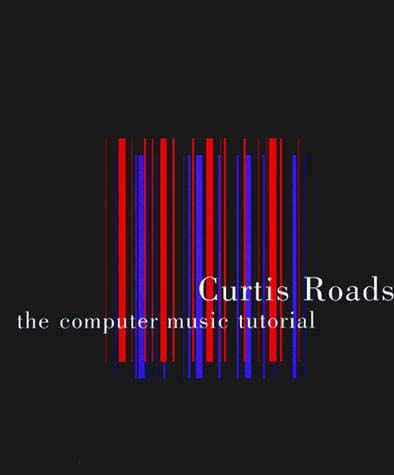Curtis Roads, et al: The Computer Music Tutorial (1996–) [English, French]
Filed under book | Tags: · algorithm, computer music, music, music theory, sound recording, sound synthesis

“The Computer Music Tutorial is a comprehensive text and reference that covers all aspects of computer music, including digital audio, synthesis techniques, signal processing, musical input devices, performance software, editing systems, algorithmic composition, MIDI, synthesizer architecture, system interconnection, and psychoacoustics. A special effort has been made to impart an appreciation for the rich history behind current activities in the field.
Profusely illustrated and exhaustively referenced and cross-referenced, The Computer Music Tutorial provides a step-by-step introduction to the entire field of computer music techniques. Written for nontechnical as well as technical readers, it uses hundreds of charts, diagrams, screen images, and photographs as well as clear explanations to present basic concepts and terms. Mathematical notation and program code examples are used only when absolutely necessary. Explanations are not tied to any specific software or hardware.”
Publisher MIT Press, 1996
ISBN 0262680823, 9780262680820
xx+1234 pages
Reviews: Sam Reese (Bulletin of the Council for Research in Music Education, 1997), Douglas Geers (Current Musicology, 2001), Gregory Taylor (Cycling ’74, 2016).
The Computer Music Tutorial (English, DJVU, 22 MB, updated on 2021-4-8)
L’audionumérique: musique et informatique (French, trans. Jean de Reydellet, 3rd ed., 1999/2016, 15 MB, added on 2021-4-8)
Corrections and revisions (added on 2017-11-20, updated on 2021-4-8)
Roy Ascott (ed.): Art, Technologies, Consciousness: mind@large (2000)
Filed under book | Tags: · architecture, art, artificial life, computer music, consciousness, interactivity, metaphysics, music, perception, performance, quantum mechanics, robotics, semiotics, synaesthesia, technoetics, technology, telematics

Within a technological context, this volume addresses contemporary theories of consciousness, subjective experience, the creation of meaning and emotion, and relationships between cognition and location. Its focus is both on and beyond the digital culture, seeking to assimilate new ideas emanating from the physical sciences as well as embracing spiritual and artistic aspects of human experience.
Developing on the studies published in Roy Ascott’s successful Reframing Consciousness, the book documents the very latest work from those connected with the internationally acclaimed CAiiA-STAR centre and its conferences. Their artistic and theoretical research in new media and art includes aspects of:
• artificial life
• robotics
• technoetics
• performance
• computer music
• intelligent architecture
• telematic art
With profound insights for those in fields of Art, Media and Design – both academics and professionals — this book will also provide new ideas for software designers working on material to be used by the arts community.
Publisher Intellect Books, 2000
ISBN 1841500410, 9781841500416
204 pages
PDF (updated on 2012-7-24)
Comment (1)Stephen Travis Pope: Software Models and Frameworks for Sound Composition, Synthesis, and Analysis: The Siren, CSL, and MAK Music Languages (2005/2007)
Filed under book | Tags: · composition, computer music, music, performance, semantic analysis, sound design, sound recording, synthesis
Music is an undeniably complex phenomenon, so the design of abstract representations, formal models, and description languages for music-related data can be expected to be a rich domain. Music-making consists of a variety of diverse activities, and each of these presents different requirements for developers of new abstract and concrete data formats for musician users.
The topic of this anthology is the design of formal models and languages for a set of common musical activities including (but not limited to) composition, performance and production, and semantic analysis. The background of this work is the 50-year history of computer music programming languages, which began with low-level and (by today’s standards) simplistic notations for signal synthesis routines and compositional algorithms. Over these 50 years, many generations of new ideas have been applied to programming language design, and the topics of formal modeling and explicit knowledge representation have arisen and taken an important place in computer science, and thus in computer music.
The three concrete systems presented here have been developed and refined over a period of 25 years, and address the areas of (a) music composition (Siren), (b) sound synthesis and processing (CSL), and (c) music data analysis for information retrieval (MAK). In each successive generation of refinement of these concrete languages, the underlying models and metamodels have been considered and incrementally merged, so that the current-generation (Siren 7, CSL 4 and MAK 4) share both superficial and deep models and expressive facilities. This allows the user (assumed to be a composer, performer, or musicologist) to share data and functionality across these domains, and, as will be demonstrated, to extend the models and frameworks into new areas with relative ease.
The significant contributions of this work to the literature can be found in (a) the set of design criteria and trade-offs developed for music language developers, (b) the new object-oriented design patterns for computer music systems, and (c) the trans-disciplinary design of the three specific languages for composers, performer/producers, and musicologists presented here.
Anthology of papers by Stephen Travis Pope – 1986-2005; updated 2007
451 pages

